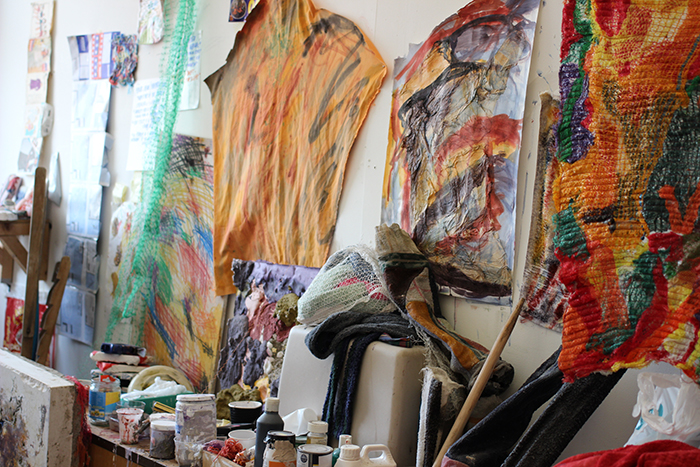BA Painting Alumna Sophie Giller was awarded the Bloomberg New Contemporary Alumni residency for one year. We asked her to take over our blog to talk us through her process of practice in her residency studio at One Thoresby Street Studios, Nottingham.
I was born in Norfolk and studied my art foundation in Brighton before coming to Camberwell to study BA Painting, graduating in 2014. I’m currently on an artist residency awarded by Bloomberg New Contemporaries.
My practice is and always has been incredibly material and studio-based. Since my degree at Camberwell I have widened my use of materials and learnt new processes. I’ve been exploring a lot of casting with plaster, concrete and wax, weaving with many different wools and fabrics, making ceramics, sewing and dying a variety of materials, and working with many various odd bundles of stuff in the studio. I have been working on a few series of works at once, which is usually the case for me because I’m easily inspired from countless collections lying around in the studio.

‘Stained Rag Windows No.1 – 3’, Rags, Thread, Wax, Installed At One Thoresby Street Attic, November 2016
I was invited to be in a group exhibition at Market Peckham, right in the walkway of Bussey Building, called The Good Life curated by Lily Brooke and her curation project called ‘Apologia Projects’ from Friday 3 – Sunday 5 March this year. The exhibition was about consumerism, reproductions and editions and it pushed me to work on some paper works. I’d been collecting paper sewing patterns of clothing for a while, as I was interested in social documentation of fashion: the instructions to cut out and vary the size; the labour that went into creating garments from women in history that wasn’t acknowledged so much at the time; and the form of people expressing themselves through their chosen fabrics and clothes. I got a huge roll of paper and made five large paper pieces at a time, wallpaper-pasting the patterns down and abstracting them. They look like drawings or prints and the patterns take on that beige colour of history.
I’m always looking to transform the materials I use, to stretch and test them and to make them act in a different way. The process is about control, from my control of setting up the material experiments, and also the control of the material itself, how it alters depending on its material make-up. For example if I’m using fabric or nets, how malleable they are, and how they react to the process, not through my doing, but because of their own material make-up.
I have also been experimenting further with casting. I’ve been given many disparate items that are by-products from other processes like horse hair, bicycle inner tubes, beeswax and dressing gown chords. I’m interested in how these things became waste product of another process, rather than the final, kept or functioning thing that has a use-value – the leftover. I remember reading Andy Warhol at university about leftovers, a specific quote stood out:
“I always like to work on leftovers, doing the leftover things. Things that were discarded, that everybody knew were no good, I always thought had a great potential to be funny…It was like recycling work… I’m saying that what’s left over is probably bad, but if you can take it and make it good or at least interesting, then you’re not wasting as much as you would otherwise. You’re recycling work and you’re recycling people, and you’re running your business as a by-product of other businesses.”
This has stuck with me and shaped my attitude and interest in using things that are ultimately waste products, and having the freedom to treat them however I want from their worthlessness. I’m also interested in the selection of these things through meanings of their previous functions, social value, how they were made, their cost, historical weight, how durable they are, and the context in which they used and are seen.
I cast a lot of these items on the floor – they’re not very neat or clean, I threw in a lot of different dyes and various plasters, sands and concrete. I felt like I was throwing a frame on these things, letting the material make up the formal elements in these tiles, preserving and freezing them in the plaster. For me, there are always difficulties in making. In the manner of artist Phyllida Barlow I’m always working with guess work and estimates, so things break a lot, change colour, and can be incredibly fragile. I kind of like that there is a contrast in weight of materials, but also a fragility. There is always dual and contrasting elements in sculpture so I like that there’s sometimes a tension of ‘will it stay – will it work?’.

‘Work Is What You Make It’, Plaster, Dyes, Concrete, Wood, Beeswax, Cross-stich, Mop, Sheep’s Fleece, Horsehair, Gloves, The Artist’s Hair, Wasp’s Nest, Hat, Bike Inner Tube, Metal, Sewing Patterns & Dressing Gown Chords
Related links:







